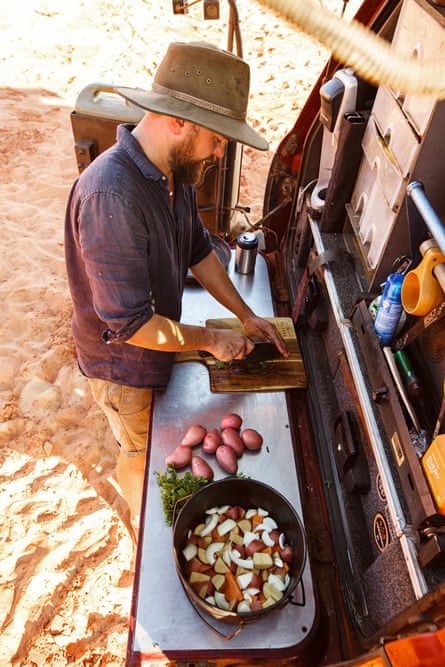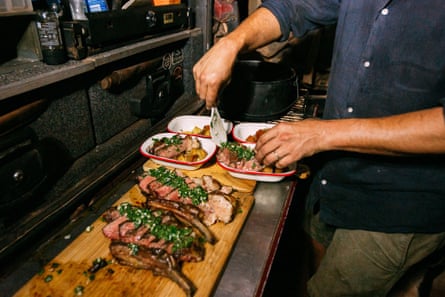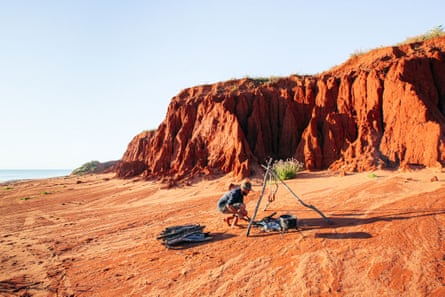
Harry Fisher has spent much of his life camping. As a child, his parents would take the family out to the bush, where his Zimbabwean dad would utilise his knowledge of Braai [a social custom similar to barbecuing that’s popular in South Africa, Namibia, Zimbabwe and Zambia] to start campfires for cooking.
“Dad had such a familiarity with fire because Braai in Africa is strictly cooked with wood,” he says. “Mum [who was a chef] would lean into that by making dishes that relied on fire and charcoal cooking, so we ate really well – Indonesian and Japanese and stir-fries and steaks.”
Just one month after he got his driving licence, Fisher went camping in the bush with his two best mates and “the most basic of gear” – they had a ball.
But not every trip was a hit. Once, camping with friends, “we thought we were going to be big strong men and spear our fish and cook it, fish and chip-style, deep-fried in oil,” he says. They speared a couple of beautiful-looking, white fleshed fish, but when they cut the fish open “they absolutely stank”.
“They were slow and easy to spear because they tasted terrible – so bad that you [couldn’t] even use them as bait … Being 17 and being too proud to admit it, we forced it down, but the next night, we just had pasta and sausages.”
The experience was a valuable lesson in realistic expectations. “I know that even after 25 years of fishing, I would probably starve to death if I relied on it.”
Ingredients for a campfire cook
Fisher now advises campers on utilising fire to prepare “tasty, simple and interesting” food through his YouTube channel and cookbook Fire to Fork. He has developed a “framework of rules” when it comes to camp cooking.
“Firstly, all ingredients have to be available from a supermarket or a butcher, so that no matter which little town you stop at you can get the right stuff,” he says.
“Secondly, the meals need to create minimal mess to save time and water, so nothing that requires more than two cooking items (such as a pot and a pan). And thirdly everything is cooked on fire.”
It’s all about simplifying the process so that you pack light and utilise readily-available ingredients like vacuum-sealed meat, which he says will keep you “sorted for a week” in a cooler.
“Too many people rely on tinned food and hiking meals, but nothing needs to be all that rugged.
“Most people are just going away for a weekend or a long weekend, so feel free to bring soft cheese and chicken and salmon and lettuce. You can definitely bring a dozen eggs and some fresh garlic and ginger to knock up a really nice fried rice or omelette.”

Fisher’s staples include “salt, pepper, cooking oil, hot sauce, kewpie mayo, sugar, sesame seeds, soy sauce, sesame oil, mustard, stock and a cold drink” – basics that you will probably have around your kitchen, or that you can easily keep using when you get back home.
He also encourages embracing cuisines and recipes that use fire cooking already: “Teriyaki beef, great Argentinian-style steaks, garlic prawns, even smoked bagels”.
“I think any grilled seafood is fantastic … and of course lamb cutlets just go so well with nearly anything,” he says. “Just try and stick to the basics and do them well.”
Building the fire
The biggest basic of them all? Building a campfire. Fisher says it’s a “huge thing to practise”: beginning with a coal base, ensuring it’s not too smoky, and working on heat control.

Fisher says “not worry too much about expensive gear and things like that”, but you will need a grill grate or portable Braai to place pots and pans on.
He encourages campers to source a local firewood supplier, rather than relying on hardware stores and service stations, because specialists will probably have firewood that’s better for cooking.
He suggests starting with boiled dishes like pastas, because “it doesn’t really matter if the water boils over a few times while you’re learning, and it tends to put the fire out a bit anyway which sort of self-regulates it.”
Once you’re a bit more comfortable, you can start using the fire as you would a barbecue. “It shouldn’t be intimidating once you have a grill on it and you can see the food cooking,” he says, just “take it off if it’s burning”.
“It’s by far the most social and easiest way to learn to cook on a fire – plus who doesn’t like watching their food get cooked in real time? Dinner and a show.”
Harry Fisher’s ultimate fish wraps
After a lot of research (in other words, eating far too many wraps), I have finally landed on a recipe that is both simple and delicious, which is what these fish wraps are all about. I think fellow Western Australian YouTube personality and fish-wrap king, Brodie Moss, would be proud of these.
I love threadfin salmon or mangrove jack for these wraps, but whatever fresh, white-fleshed fish you can get will work well.

Prep 3 minutes
Cook 10 minutes
Serves 2
Gear: Fry-pan or wok, thermometer
300g fish fillets
Oyster sauce
Panko breadcrumbs (crushed rice crispies work well as a gluten free alternative)
1L rice bran oil
Wasabi
Kewpie mayonnaise
2 wraps
Soy sauce
1 lemon, cut into wedges
1 cucumber, sliced
Leave your flour and egg at home; you don’t need any of those for the perfect battered fish. Instead, cut the fillets into 2cm-wide strips, coat them in oyster sauce and roll them in the panko crumbs. You don’t need salt and pepper because all of those flavours are in the oyster sauce.
In a wok or a deep pot like a camp oven, heat the oil to 180C and drop the fish in until it has lightly browned. It’ll keep on browning after you take it out, so bear that in mind.
While the fillets are cooking, mix the wasabi and mayo to your liking. Even if you don’t like the spice of wasabi, a tiny bit adds a lot of freshness.
Once the fish has cooked, spread a generous amount of wasabi mayo on to the wrap and add a few drops of soy sauce. Add the fish, a small squeeze of lemon, and some sliced cucumber, then wrap and enjoy.
-
This recipe is an edited extract from Fire to Fork, available now through Exploring Eden (RRP: $39.95).



